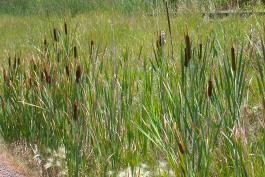
Our cattails are tall wetland plants with narrow, upright leaves emerging from a thick base, and a central stalk bearing a brown, sausage-shaped flower spike. The brown section consists of female flowers; above it on the stalk, the male flowers are yellow and powdery. Blooms May–July. Missouri has 3 species:
Common (broad-leaved) cattail (T. latifolia) has flat leaves to 1 inch wide and usually reaches 8 feet high. Male and female flower sections are close together.
Narrow-leaved cattail (T. angustifolia) has rounded leaves to ½ inch wide and usually reaches 6 feet high. Male and female flower sections are clearly separated on the spike. Female section is dark brown and ½-¾ inch in diameter.
Southern cattail (T. domingensis) is less common than the other two, found only in the prairies of western Missouri. Male and female sections are clearly separated on the spike. Female section is medium brown and ¾-1¼ inches in diameter.

Statewide.
Habitat and Conservation
Emergent aquatic plants that grow in marshes, sloughs, margins of ponds and lakes, ditches, and other places with standing or slow-moving water. They spread from thick, fleshy rhizomes and from the thousands of fluffy seeds released when the flower spike disintegrates. Because of their rapid growth and tendency to collect soil around their roots, cattails can fill in shallow ponds and other wet areas. They can become invasive and displace other wetland vegetation.
Status
Cattails are native plants that can spread quickly. Where wet soil is disturbed to bare mud, they can quickly colonize, hold soil in place, increase siltation, and impede water flow, eventually filling in the wet place. They can be nuisance plants in lakes and ponds, crowding out other plants, filling in old shallow ponds, attracting muskrats to dams, and impeding rainwater discharge on spillways.
Control
Human Connections
All parts of cattails are edible and have been used as food worldwide. The starchy rhizomes are eaten raw, cooked, or dried and ground into a flour. Roots can be made into a jelly. Young stems and flowers can be cooked in various ways. The leaves have been used for thatching roofs and making paper.
Ecosystem Connections
Cattails are important wetland plants and provide food, shelter, and nesting places for a variety of animals, including insects, young fish, frogs, muskrat, beaver, many bird species, and more. They also help stabilize soil.







































